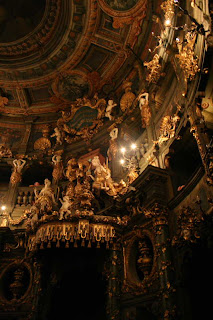



After returning from Germany, I've had a nasty combination of being very busy as well as sick. I had a cold when I returned, and thought it was getting better during the couple of days that I spent in Ann Arbor. Then I had to travel to Madison, WI, and it got worse. I didn't sing in any church choir this past weekend.
I'm finally getting around to a few more of my experiences in Germany. The real reasons why I was there are work-related, with my duties being in Bayreuth. Bayreuth has two main celebrities from the past. The one who is likely more familiar to most was Richard Wagner. They have the annual Bayreuth Festival that features his operas. The other was Margravine Wilhelmina. She was the Princess of Prussia, daughter of King Friedrich Wilhelm I and lived from 1709 to 1758, and she married Friedrich, Margrave of Bayreuth. They had palaces in Bayreuth called Altes Schloss and Neues Schloss, and nearby outside of town, the Hermitage. They also built the Margravine Opera House. This is a separate, smaller venue than the Festspielhaus in which the Wagner Festival is held. But it is a very impressive building for the rococo decorations (see photos of the front and rear of the house), and as part of the Bayreuth Baroque Festival, they had performances in this location while I was there.
What I saw was apparently a fairly obscure work called "L'Huomo" by Andrea Bernasconi, with libretto by Margravine Wilhelmina herself. The title translates as "The Man." The Man was played by a woman, as was one other male character. The lowest voice part of any of the solo roles was a countertenor. It started out as a story of two people in love, and placed in a highly circumscribed world, with only themselves along with supernatural beings. As such, it reminded me of one of my favorite musicals, "The Fantasticks." But the man was taken away by temptation and the woman by force. Then it stayed this way for way too long, the second act being sort of a slow-motion chase scene, and finally the two got back together again and the chorus came out with sunshine masks on their faces, and the show ended. This story was probably not very exciting even in the 18th century, but it really was an experience to go and see the show there.
My accommodations were at the Hotel Goldener Anker, built in 1753 and still under ownership by the same family. It is only a few doors up from the Margravial Opera House. One photo shows the room key with the ornate fob affixed to it at a 90-degree angle, making it too cumbersome to carry in your pocket. The other photo shows the 18th century-style uniform that the staff wear, with the rack behind where one leaves the key when not in the hotel.

No comments:
Post a Comment